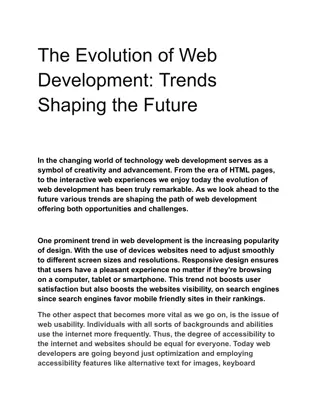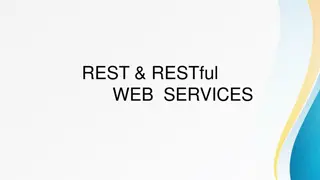Evolution of REST in Web Engineering
RESTful APIs have become a fundamental solution in web engineering, enabling seamless communication between systems on different computers. The historical context of REST, dating back to the late 1990s, showcases its relevance and impact on software development. The core principles of REST, such as representational state transfer and statelessness, have significantly influenced modern web applications, promoting scalability, reliability, and simplicity in system architecture.
Download Presentation

Please find below an Image/Link to download the presentation.
The content on the website is provided AS IS for your information and personal use only. It may not be sold, licensed, or shared on other websites without obtaining consent from the author.If you encounter any issues during the download, it is possible that the publisher has removed the file from their server.
You are allowed to download the files provided on this website for personal or commercial use, subject to the condition that they are used lawfully. All files are the property of their respective owners.
The content on the website is provided AS IS for your information and personal use only. It may not be sold, licensed, or shared on other websites without obtaining consent from the author.
E N D
Presentation Transcript
RESTful APIs SWEN-344 WEB ENGINEERING
REST is an answer to a problem When you wrote your DB code, you had Test_xx_functionName myFunction(value1, value2) This is a function call. In this case, both pieces of code (test code and myFunction) are on the same computer What do you do when your code on computer1, needs to call a function on computer2? REST is one of the answers (most common answer in today s world of computing)
Historical Context for REST Around this time, Software was having a revolution 1995: Java 1998: SOAP Y2K saw a massive increase in the market for software developers 1999 HTML4 is ratified, CSS is the recommended styling approach 1999: 802.11b wifi protocol 2000: RESTful API dissertation by Roy Fielding, source: https://restfulapi.net/ ~2000: Amazon.com explodes, e-commerce becomes culturally acceptable 2001: Agile Manifesto Dot-com bubble: 95- 02 Huge needs for: Standardization Integration between services, esp. e-commerce Scaling up development teams Performance. Most internet was dial-up at this time
RE REpresentational S State T Transfer Architectural style with ~6 guiding constraints 1. Client-server 2. Stateless 3. Cacheable 4. Uniform interface 5. Layered 6. Code on demand (optional) This structure has heavily influenced web applications today ...but REST is not necessarily over HTTP
Client-Server Two systems This can be browser and web server BUT! Can be lots of other systems Server: run all the time, listen for requests Client: talk to server
Statelessness Advantages: Application state Server-side data Identify incoming client requests Context of previous calls RESTful APIs are application stateless Resource state The actual data that you are storing e.g. your database This can change, and is not part of the RESTful API layer Server provides all information needed to create the state The client stores the state and provides everything necessary e.g. pagination: provide limit & offset e.g. queries H-scalability: just stand up more servers! REST servers don t need lots of disk usage Reliability: just reboot crashed REST servers Simpler! Don t need to remember clients and share with other servers Concurrency is easier to manage Caching! See next slide. Professors are often stateless We forget your most recent context ...but we can look up what we need We know how to handle every request, we just handle tons of requests concurrently and choose to forget context in favor of handling Did you get my email? assumes I remember state.
Statelessness: Authentication When you log in , doesn t the server remember your state? yes and no When you log in: You are given a session key, which is a gigantic unguessable random number DB saves your session key, ...NOT stored in the RESTful API b/c statelessness Every subsequent request must provide that session key The server always checks the session key to know how you are Logout means the DB forgets the session key
Cacheable Responses should define the caching behavior on the client Is this cacheable at all? When does this expire? Caching can also be done on the server Caching can also be done with a gateway or proxy Caching is possible because REST is stateless It CAN cause some confusion when debugging this is why you may need to clear cache when you make changes
Uniform Interface Resources: group related data in a logical way Provide links to other resources when necessary e.g. listing movies and returning an ID, then getting an individual movie Resource Methods: e.g. CRUD operations Can be HTTP s GET/PUT/POST/DELETE/PATCH, but not necessarily Driven by UI or by DB? You might be tempted to copy-pasta your DB schema . ...but good RESTful API interfaces often are driven by the UI more than the DB e.g. A review for a product will hit lots of tables Increasing usability is about decreasing what people have to remember, so: Don t force your API team or your client team to know your DB schema! Structured data return, e.g. json or xml Nameing conventions reference: https://restfulapi.net/resource-naming/
Layered system By building your API in layers, you can move them to separate servers Also could help organize your team (Conway s Law) Common layers Routing Authentication Reading API CRUD API Query API Administrative API Caching is often a layer Similar notions Middleware in web often refers to these layers Microservices: take this notion and cranks it to the extreme (future lecture)
Activity Work with one other person Find a RESTful API for some service that you both use Identify: Resources Resource methods State that the client provides Discuss: What would be a different way to arrange the resources? How should you h-scale this API? i.e. what resources would go on the same servers?























